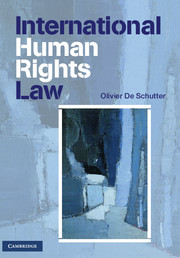Book contents
- Frontmatter
- Contents
- Table of Cases
- Table of Treaties and Conventions
- Table of Comments and Recommendations of Various International Committees
- Introduction
- PART I THE SOURCES
- PART II THE SUBSTANTIVE OBLIGATIONS
- PART III THE MECHANISMS OF PROTECTION
- 8 Ensuring compliance with international human rights law: the role of national authorities
- 9 The United Nations human rights treaties system
- 10 The United Nations Charter-based monitoring of human rights
- 11 Regional mechanisms of protection
- Index
9 - The United Nations human rights treaties system
from PART III - THE MECHANISMS OF PROTECTION
- Frontmatter
- Contents
- Table of Cases
- Table of Treaties and Conventions
- Table of Comments and Recommendations of Various International Committees
- Introduction
- PART I THE SOURCES
- PART II THE SUBSTANTIVE OBLIGATIONS
- PART III THE MECHANISMS OF PROTECTION
- 8 Ensuring compliance with international human rights law: the role of national authorities
- 9 The United Nations human rights treaties system
- 10 The United Nations Charter-based monitoring of human rights
- 11 Regional mechanisms of protection
- Index
Summary
INTRODUCTION
This chapter offers an overview of the role of the expert bodies set up under the core UN human rights treaties (see generally G. Alfredsson et al. (eds), International Human Rights Monitoring Mechanisms (The Hague: Kluwer Law International, 2001); P. Alston and J. Crawford (eds.), The Future of the UN Human Rights Treaty System (Cambridge University Press, 2000); P. Alston (ed.), The United Nations and Human Rights: a Critical Appraisal, second edn (Oxford: Clarendon Press, 2004)). Seven such bodies are currently in operation. These are the Committee on the Elimination of Racial Discrimination (CERD), which has been functioning since 1969, the Human Rights Committee (CCPR) (1976), the Committee on Economic, Social and Cultural Rights (CESCR) (1987), the Committee on the Elimination of Discrimination Against Women (CEDAW) (1981), the Committee Against Torture (CAT) (1987), the Committee on the Rights of the Child (CRC) (1990), and the Committee on Migrant Workers (CMW) (2003). All but one of these expert bodies have their role and composition defined in the respective treaties with which they supervise compliance. The exception is the Committee on Economic, Social and Cultural Rights (CESCR), which was established by Resolution 1985/17 of the Economic and Social Council (Ecosoc) and which was modelled on the Human Rights Committee created by the International Covenant on Civil and Political Rights (ICCPR).
- Type
- Chapter
- Information
- International Human Rights LawCases, Materials, Commentary, pp. 791 - 854Publisher: Cambridge University PressPrint publication year: 2010



